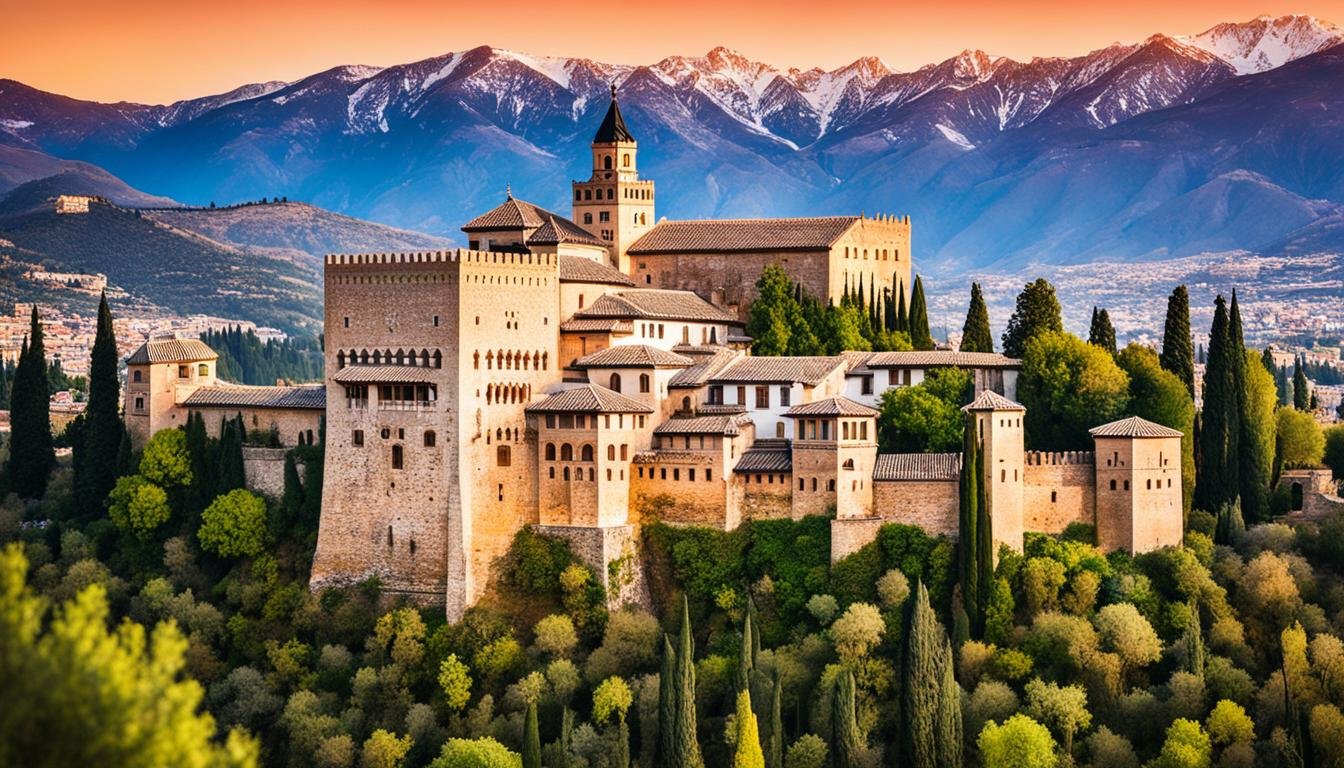humanidad por la unesco Spain is a country steeped in history and natural beauty, boasting a rich cultural and natural heritage that has been recognized and preserved by UNESCO. The UNESCO World Heritage program aims to identify, protect, and promote sites of outstanding universal value, ensuring their preservation for future generations. With 50 UNESCO World Heritage sites, Spain offers a diverse range of cultural and natural gems that are worth exploring.
Key Takeaways: humanidad por la unesco
- Spain is home to 50 UNESCO World Heritage sites, showcasing the country’s cultural and natural significance.
- UNESCO World Heritage sites in Spain include architectural wonders, historical cities, and unique natural landscapes.
- These sites reflect Spain’s rich history, architectural brilliance, and contributions to human culture.
- Efforts are made to preserve and protect these sites through sustainable tourism and responsible travel practices.
- Visiting these UNESCO World Heritage sites allows you to immerse yourself in the beauty and history of Spain.
Cultural and Natural Heritage Recognized by UNESCO
The UNESCO World Heritage List encompasses a diverse range of cultural and natural sites that have been acknowledged for their exceptional universal value. These sites are a testament to the remarkable achievements of humanity and the awe-inspiring wonders of nature. The recognition bestowed upon these sites by UNESCO serves as a global symbol of their significance and the need for their protection and preservation.
Cultural heritage sites included in the UNESCO World Heritage List are a true reflection of human ingenuity and accomplishments throughout history. They encompass a wide variety of marvels, from iconic historic cities and archaeological sites to cultural landscapes that are imbued with rich traditions and artistic expressions.
Natural heritage sites, on the other hand, showcase the intricate beauty and ecological importance of our planet. These sites span from unique ecosystems and geological formations to biodiversity hotspots that harbor a wide array of species. Each of these natural wonders plays a pivotal role in preserving our planet’s ecological balance and promoting sustainable development.
The UNESCO World Heritage List stands as a testament to the cultural and natural richness of our world. By recognizing and preserving these sites, we contribute to the collective memory of humanity and ensure that future generations have the opportunity to learn from and appreciate these treasures. – UNESCO
UNESCO’s declaration provides global recognition to the cultural and natural heritage sites that demonstrate outstanding universal value. This recognition not only highlights their significance but also encourages responsible tourism, fostering a deeper sense of appreciation and understanding among visitors.
Examples of UNESCO World Heritage Sites
| Cultural Heritage Sites | Natural Heritage Sites |
|---|---|
| Historic City of Toledo | Doñana National Park |
| Machu Picchu | Giant’s Causeway |
| Angkor Wat | Great Barrier Reef |
| Acropolis of Athens | Yellowstone National Park |
UNESCO World Heritage Sites in Spain
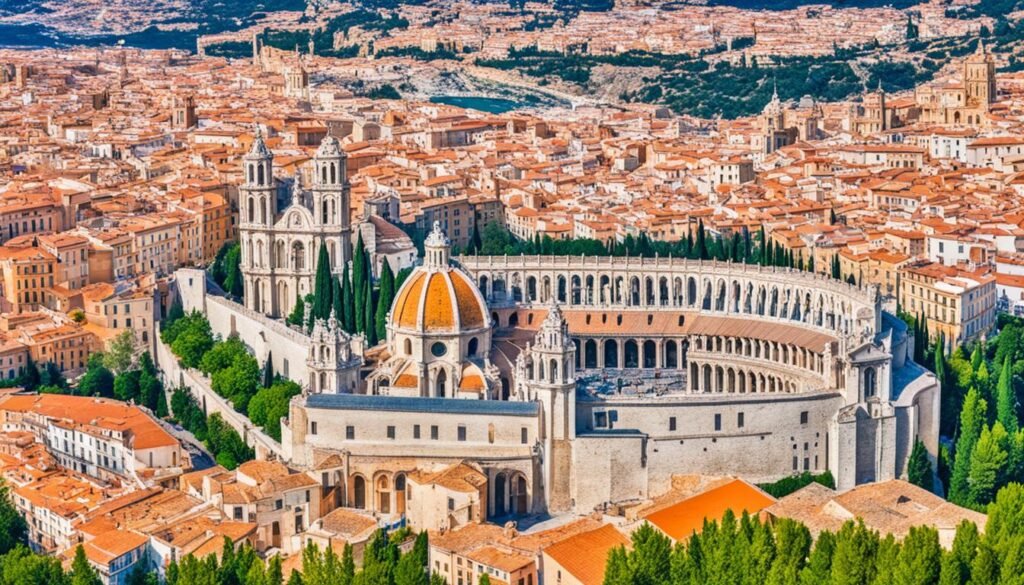
Spain boasts a rich and diverse cultural heritage, with 50 UNESCO World Heritage sites that showcase the country’s historical significance, architectural marvels, and breathtaking natural landscapes. These sites hold significant cultural value and attract millions of visitors each year.
Cultural Heritage Sites
Spain’s UNESCO cultural heritage sites range from iconic architectural wonders to medieval towns that preserve the country’s historical legacy. These sites bear witness to Spain’s artistic and architectural brilliance and provide a glimpse into its vibrant past.
«Spain, a country known for its remarkable cultural heritage, is home to several UNESCO World Heritage sites that embody the country’s rich history and artistic achievements.»
Some notable cultural heritage sites in Spain include:
- The Alhambra in Granada: An architectural masterpiece reflecting the Islamic rule in Spain.
- The Sagrada Familia in Barcelona: An iconic modernist cathedral designed by Antoni Gaudí.
- The Historic City of Toledo: A medieval city known for its cultural fusion of Christian, Jewish, and Muslim influences.
- The Santiago de Compostela Cathedral: A pilgrimage site and a symbol of the famous Camino de Santiago.
Natural Heritage Sites
In addition to its cultural treasures, Spain is also blessed with stunning natural landscapes that have earned UNESCO recognition. These sites showcase the country’s diverse ecosystems, unique geological formations, and abundant biodiversity.
«Spain’s natural heritage sites are a testament to the remarkable beauty and ecological importance of its landscapes, attracting nature enthusiasts from around the world.»
Some remarkable natural heritage sites in Spain are:
- Doñana National Park: A vast wetland and one of Europe’s most important bird sanctuaries.
- Teide National Park: Home to Spain’s highest peak, Mount Teide, and an otherworldly volcanic landscape.
- Garajonay National Park: A lush laurel forest in the Canary Islands, showcasing unique flora and fauna.
- Pyrenees-Mont Perdu: A mountainous region known for its breathtaking landscapes and rich biodiversity.
These UNESCO World Heritage sites in Spain offer a captivating blend of cultural significance and natural beauty. Whether exploring ancient cities, marveling at architectural wonders, or immersing in pristine natural landscapes, visitors are sure to be enthralled by Spain’s rich heritage and historical treasures.
Cultural Heritage Sites in Spain

Spain is home to a plethora of cultural heritage sites that have been recognized and preserved by UNESCO. These sites serve as testaments to Spain’s rich history, architectural marvels, and artistic achievements. From the historic city of Toledo to the majestic Alhambra, each site holds immense historical significance and reflects the country’s cultural heritage.
Here are some notable cultural heritage sites in Spain:
- The Historic City of Toledo: Known as the «City of Three Cultures,» Toledo showcases the coexistence of Christian, Jewish, and Muslim communities throughout history. Its magnificent architecture, including the Toledo Cathedral and the Alcázar of Toledo, is a sight to behold.
- The Alhambra: Situated in Granada, the Alhambra is a breathtaking palace and fortress complex. This architectural masterpiece combines Moorish and Christian influences, featuring stunning gardens, intricate carvings, and breathtaking views of the city.
- The Great Mosque of Cordoba: A symbol of the city’s rich history, the Great Mosque of Cordoba is a testament to the Islamic architecture of Al-Andalus. Its forest of columns, horseshoe arches, and exquisite design make it a must-visit site.
- The Santiago de Compostela Cathedral: Located in the captivating city of Santiago de Compostela, this cathedral holds immense religious and cultural significance. It marks the end of the Camino de Santiago pilgrimage and showcases the mastery of Romanesque, Gothic, and Baroque architectural styles.
Efforts are continuously made to preserve and protect these cultural heritage sites, ensuring that future generations can appreciate and learn from Spain’s historical and artistic legacy.
Preservation Efforts for Spain’s Cultural Heritage Sites
The preservation of Spain’s cultural heritage sites is of utmost importance. Various organizations, including the Spanish Ministry of Culture and UNESCO, work together to safeguard these architectural marvels. Preservation efforts involve meticulous restoration work, ensuring that the original aesthetics and historical value of the sites are maintained.
«Preserving Spain’s cultural heritage sites not only safeguards our history but also showcases our country’s incredible artistic achievements to the world.» – Spanish Ministry of Culture
Through sustainable practices and careful planning, Spain aims to strike a balance between tourism and preservation. This ensures that visitors can appreciate and learn from these cultural treasures while minimizing any negative impact on the sites. By promoting responsible tourism and community involvement, Spain is paving the way for the long-term preservation and enjoyment of its cultural heritage.
| Site | Location | Year Recognized |
|---|---|---|
| Historic City of Toledo | Toledo | 1986 |
| Alhambra, Generalife and Albayzín, Granada | Granada | 1984 |
| Great Mosque of Cordoba | Cordoba | 1984 |
| Santiago de Compostela | Santiago de Compostela | 1985 |
Natural Heritage Sites in Spain

Spain is blessed with a diverse array of natural heritage sites that showcase the country’s breathtaking landscapes and rich biodiversity. These sites, which include national parks, biosphere reserves, and natural reserves, contribute significantly to environmental conservation and the protection of endangered species.
One notable natural heritage site in Spain is the Doñana National Park. Located in the southwestern part of the country, this park encompasses a unique mosaic of ecosystems, including marshes, dunes, and forests. It is home to a rich variety of flora and fauna, attracting migratory birds, Iberian lynx, and endangered species like the Iberian imperial eagle.
Garajonay National Park is another remarkable natural heritage site. Situated in the Canary Islands, this park is a prime example of the laurisilva forest ecosystem, which is characterized by ancient laurel trees. Its lush forests, deep ravines, and cascading waterfalls create a captivating and tranquil atmosphere.
Biodiversity and Conservation
These natural heritage sites in Spain provide essential habitats for a wide range of species and play a crucial role in maintaining biodiversity. They serve as sanctuaries for endangered plants and animals, contributing to their survival and conservation efforts.
Additionally, these protected areas promote environmental conservation by preserving ecosystems, safeguarding natural resources, and supporting sustainable practices. Visitors to these sites can experience firsthand the beauty of Spain’s natural heritage while gaining a deeper understanding of the importance of environmental stewardship.
The Pyrenees-Mont Perdu World Heritage Site
One exceptional example of Spain’s natural heritage is the Pyrenees-Mont Perdu World Heritage site. Spanning the border between Spain and France, this site encompasses a stunning mountain landscape, glaciers, deep canyons, and pristine forests. It is renowned for its exceptional geological features, including the expansive Añisclo Canyon and the iconic Monte Perdido peak.
| Natural Heritage Site | Location | Main Features |
|---|---|---|
| Doñana National Park | Andalusia | Marshes, dunes, forests, migratory birds, Iberian lynx |
| Garajonay National Park | Canary Islands | Laurisilva forest, lush forests, waterfalls |
| Pyrenees-Mont Perdu World Heritage site | Spanish-French border | Mountain landscape, canyons, glaciers, forests |
Magnificent Architectural Marvels in Spain
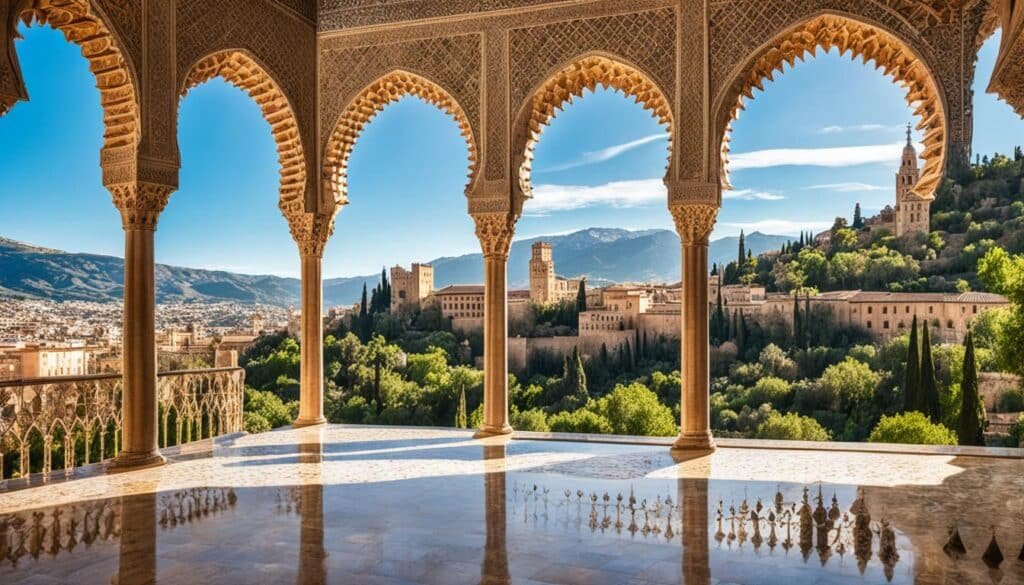
Spain is renowned for its Spanish architectural wonders, many of which are UNESCO World Heritage sites. These iconic landmarks hold great historical significance and attract tourists from around the world.
One of the most breathtaking architectural marvels in Spain is the Alhambra in Granada. This majestic palace and fortress complex showcases the intricate Islamic architecture of the Nasrid dynasty and offers stunning views of the surrounding landscape.
Another iconic landmark is La Sagrada Familia in Barcelona. Designed by renowned architect Antoni Gaudí, this masterpiece of Catalan modernism blends Gothic and Art Nouveau styles, creating a truly unique and awe-inspiring structure.
The Roman Aqueduct of Segovia is another architectural wonder that reflects Spain’s rich history. This Roman engineering marvel, with its impressive arches, is a testament to the ingenuity of the ancient Romans.
Lastly, we have the Tower of Hercules in A Coruña, which is not only an architectural marvel but also the oldest functioning lighthouse in the world. This Roman lighthouse has stood tall for over 1,900 years, guiding sailors and captivating visitors with its historical significance.
These structures showcase Spain’s rich architectural heritage and draw tourists from around the world.
Visiting these architectural wonders allows travelers to immerse themselves in Spain’s history, culture, and artistic achievements. With their grandeur and historical significance, these landmarks provide a glimpse into Spain’s past and leave a lasting impression on all who visit.
| Architectural Wonder | Location | Year Built |
|---|---|---|
| Alhambra | Granada | 13th century |
| La Sagrada Familia | Barcelona | 1882-present |
| Roman Aqueduct of Segovia | Segovia | 1st century AD |
| Tower of Hercules | A Coruña | 2nd century AD |
Spain’s Historical Cities on the UNESCO List
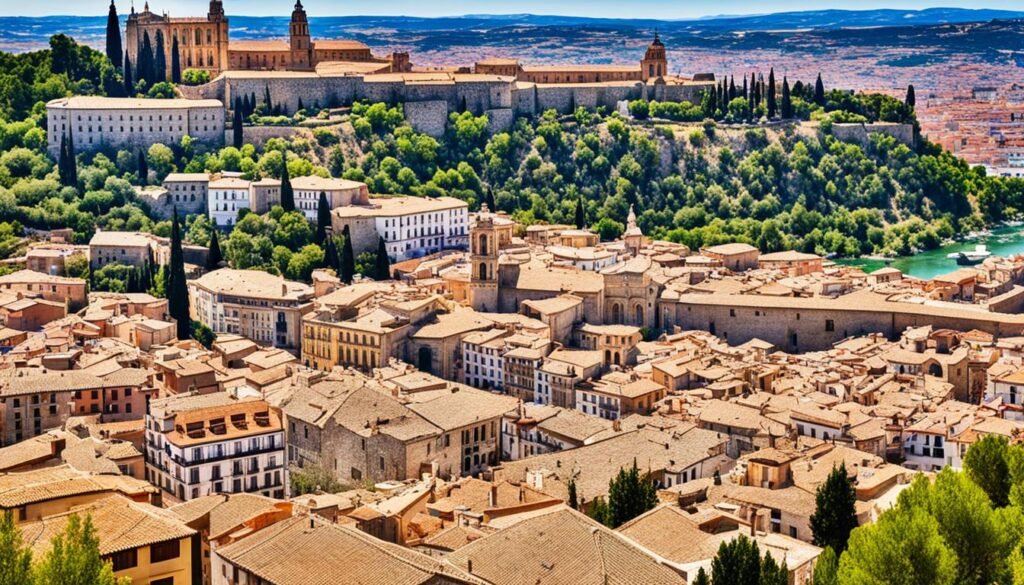
Spain is home to several historical cities that have been recognized by UNESCO for their cultural richness and urban heritage. These cities, including Toledo, Segovia, Córdoba, and Salamanca, hold a special place in Spain’s history and showcase its medieval charm.
Walking through the streets of these cities is like stepping back in time. Their medieval layout, ancient walls, and architectural treasures offer visitors a glimpse into Spain’s past. The cultural richness of these cities is evident in their magnificent palaces, churches, and museums that house centuries-old artworks and artifacts.
The urban heritage of these cities is carefully preserved, allowing travelers to immerse themselves in a bygone era. Whether it’s exploring the narrow winding streets of Toledo, admiring the stunning Roman aqueduct in Segovia, marveling at the Great Mosque of Córdoba, or wandering through the historic university town of Salamanca, each city has its unique allure.
These medieval towns not only provide a visual spectacle but also offer a lively atmosphere with bustling markets, charming cafes, and vibrant festivals. The fusion of architectural wonders, cultural traditions, and local cuisine creates an unforgettable experience for all who visit.
Historical Cities in Spain on the UNESCO List
| City | Cultural Significance | Urban Heritage |
|---|---|---|
| Toledo | Ancient capital of medieval Spain, known for its Catholic, Jewish, and Muslim heritage | Preserves its medieval layout and ancient city walls |
| Segovia | Home to a Roman aqueduct, fairy tale-like castle, and a Gothic cathedral | Features well-preserved historic city center |
| Córdoba | Symbol of the Islamic Golden Age with the Great Mosque and medieval Jewish quarter | Retains its medieval urban fabric and narrow winding streets |
| Salamanca | Renowned for its prestigious university and Plaza Mayor | Maintains its medieval university complex and historic city center |
Exploring these historical cities is like taking a journey through time. It’s an opportunity to appreciate Spain’s rich heritage, immerse oneself in its vibrant culture, and gain a deeper understanding of its historical importance. These UNESCO-listed cities are a testament to the enduring legacy of Spain’s medieval past.
Spain’s Unique Natural Landscapes

Spain is home to a remarkable array of natural landscapes that have been recognized for their ecological importance and designated as UNESCO World Heritage sites. These natural wonders showcase the diverse ecosystems and protected areas that make Spain a biodiverse paradise.
One such UNESCO site is Doñana National Park, located in the southern region of Andalusia. This park encompasses a vast range of habitats, including marshes, dunes, and woodlands, making it home to a rich variety of flora and fauna. Doñana National Park plays a crucial role in the conservation of endangered species and serves as a vital stopover for migratory birds.
Teide National Park, situated in the Canary Islands, is another prominent UNESCO site. It is home to the extraordinary Mount Teide, the highest peak in Spain and the third-largest volcano in the world. The park’s volcanic landscapes and unique ecosystems provide a captivating environment for scientific research and nature exploration.
Garajonay National Park, located on the island of La Gomera in the Canary Islands, is known for its lush laurel forests. These ancient woodlands have remained virtually unchanged for millions of years and harbor a remarkable biodiversity. The park’s misty landscapes make it a mystical and enchanting destination.
The Pyrenees-Mont Perdu, shared between Spain and France, is a UNESCO site renowned for its majestic mountain landscapes. This natural wonder encompasses glaciers, valleys, and peaks that reach heights of over 3,000 meters. It is an important habitat for several endangered species and serves as a critical ecological corridor.
These unique natural landscapes in Spain highlight the country’s commitment to preserving its ecological heritage. The protected areas and diverse ecosystems found within these UNESCO sites are essential for maintaining ecological balance and conserving Spain’s natural treasures for future generations to enjoy.
Spain’s Contribution to Human History and Culture
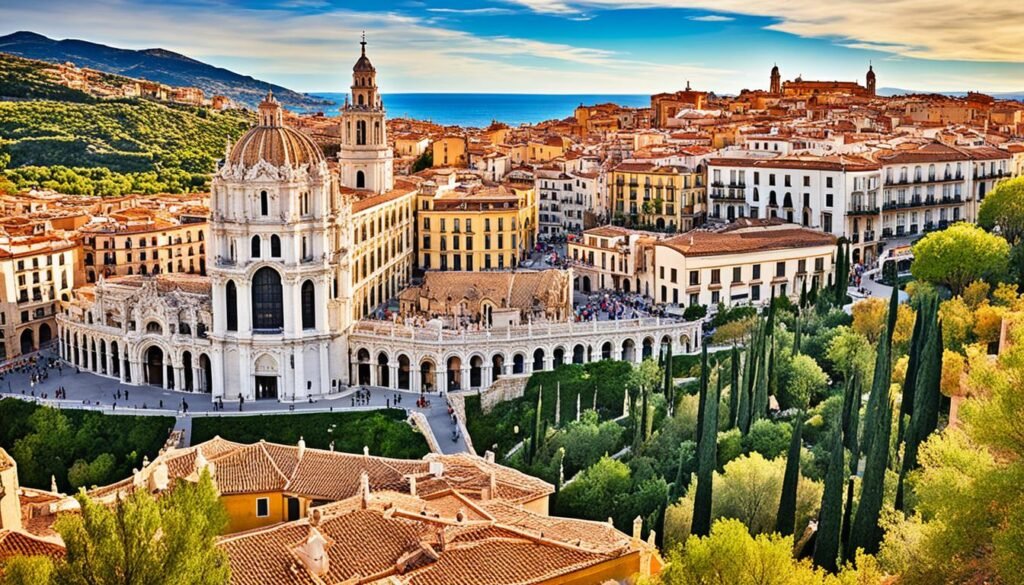
Spain has made significant historical and cultural contributions that are recognized and celebrated through its UNESCO World Heritage sites. These sites serve as a testament to the artistic heritage, literary significance, and diverse cultural influences that have shaped Spain’s rich heritage.
«Spain has left an indelible mark on art, literature, and religious pilgrimage.»
One of the remarkable examples of Spain’s contribution to human history can be found in the Cave of Altamira, known for its prehistoric cave paintings. These ancient artworks provide valuable insights into the artistic expressions of early human civilizations.
Another iconic site is the Route of Santiago de Compostela, a famous pilgrimage route that has attracted travelers for centuries. This spiritual journey has not only shaped Spain’s religious and cultural landscape but has also inspired countless literary works and artistic creations.
Spain’s literary significance is further demonstrated through the works of renowned authors such as Miguel de Cervantes, whose masterpiece «Don Quixote» is considered one of the greatest novels in world literature. Cervantes’ portrayal of the Spanish society and his exploration of complex human nature have had a profound impact on the literary world.
Spain’s artistic heritage is seen in its architectural wonders like the Alhambra, a magnificent palace complex in Granada. This architectural masterpiece showcases the intricate details of Islamic art and architecture, highlighting the cultural fusion that characterized Spain’s history.
To overlook Spain’s contribution to human history and culture would be to miss out on the vibrant tapestry of artistic expression, literary brilliance, and historical significance that this country has to offer.
Spanish Historical and Cultural Contributions
Spain’s historical and cultural contributions can be summarized as follows:
| Domain | Contributions |
|---|---|
| Art | Prehistoric cave paintings in the Cave of Altamira, vibrant works of artists like Pablo Picasso and Salvador Dalí |
| Literature | Works of Miguel de Cervantes, including «Don Quixote», and influential literary movements like the Spanish Golden Age |
| Architecture | Architectural wonders such as the Alhambra, the Sagrada Familia, and the Roman Aqueduct of Segovia |
| Religious Pilgrimage | The Route of Santiago de Compostela, one of the most significant pilgrimage routes in the world |
These contributions have not only shaped Spain’s cultural landscape but have also had a profound influence on global art, literature, and religious practices.
Sustainable Tourism and Heritage Conservation in Spain
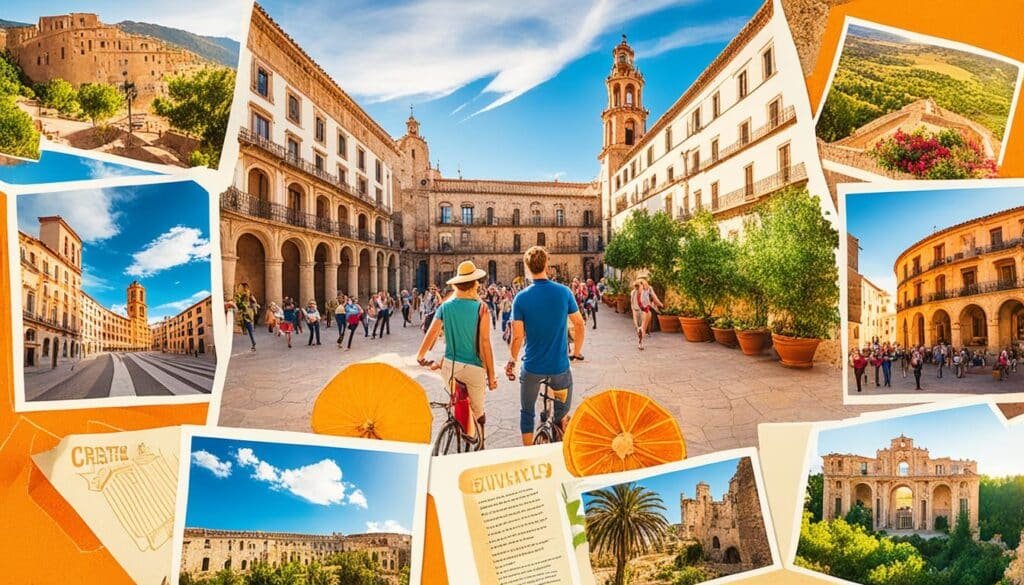
Spain recognizes the importance of sustainable tourism and heritage conservation. Efforts are made to balance tourism development with the preservation of cultural and natural heritage. Sustainable practices, community involvement, and responsible travel are promoted to ensure the long-term preservation and enjoyment of Spain’s UNESCO World Heritage sites.
Sustainable tourism in Spain is a key focus for the preservation of its cultural and natural heritage. The country understands that tourism can have both positive and negative impacts on these sites and aims to minimize any harm while maximizing the benefits. By adopting sustainable practices, Spain ensures that its UNESCO World Heritage sites can be enjoyed by future generations.
«Sustainable tourism is about maintaining the environmental, economic, and socio-cultural integrity of a destination, making sure that development doesn’t come at the expense of heritage conservation,» says María López, a sustainable tourism expert.
One of the ways Spain promotes sustainable tourism is by actively involving local communities in the conservation and management of these sites. This approach not only empowers the local communities but also ensures that their knowledge and traditions are preserved. Community involvement creates a sense of ownership and responsibility towards the sites, fostering long-term sustainability.
«By involving local communities in the decision-making process and allowing them to benefit from tourism, we ensure that they have a vested interest in preserving our cultural and natural heritage,» explains Eduardo García, a heritage conservation specialist.
In addition to community involvement, responsible travel practices are encouraged to minimize negative impacts on the environment and local communities. This includes respecting the local culture and traditions, reducing waste and carbon footprint, and supporting local businesses.
«Responsible travel allows tourists to have a positive impact on the places they visit while enjoying a meaningful and authentic experience,» says Ana Martínez, a responsible travel advocate.
Spain’s commitment to sustainable tourism and heritage conservation is further reinforced through education and awareness programs. By promoting the importance of preserving cultural and natural heritage, Spain encourages visitors to appreciate and respect these sites as they experience their beauty and historical significance.
Benefits of Sustainable Tourism and Heritage Conservation
Implementing sustainable tourism practices and prioritizing heritage conservation offers numerous benefits for Spain and its visitors:
- Preservation of cultural and natural heritage for future generations to enjoy
- Supporting local economies and communities
- Promoting environmental sustainability
- Enhancing the authenticity and quality of the tourism experience
- Minimizing the negative impact of tourism on fragile ecosystems and historical sites
By striking a balance between tourism development and heritage conservation, Spain ensures that its UNESCO World Heritage sites continue to thrive and inspire awe in visitors from around the world.
Also Read : Explorando España: formas adicionales de enamorarse
Conclusion
The UNESCO World Heritage sites in Spain have had a significant impact on the preservation of the country’s cultural and natural heritage. These sites, recognized for their outstanding universal value, attract a large number of tourists from all over the world. As a result, heritage tourism has become a driving force for sustainable tourism and local economies.
The cultural heritage sites, such as the Alhambra and the Santiago de Compostela Cathedral, showcase Spain’s rich history and architectural brilliance. These sites not only provide insights into Spain’s past, but also contribute to the preservation of its cultural legacy. Additionally, the natural heritage sites, like Doñana National Park and Teide National Park, highlight the diverse ecosystems and ecological importance of Spain.
It is crucial to continue conserving and protecting these UNESCO World Heritage sites to ensure their longevity for future generations. By implementing sustainable practices and promoting responsible travel, we can strike a balance between tourism development and heritage preservation. This will not only safeguard Spain’s cultural and natural treasures, but also allow for their enjoyment and appreciation by visitors and locals alike.
FAQs
Q: ¿Qué es la protección del patrimonio mundial?
A: La protección del patrimonio mundial se refiere a la preservación de sitios que han sido inscritos en la lista de Patrimonio de la Humanidad por la UNESCO en 1972.
Q: ¿Por qué es importante la preservación del patrimonio cultural y natural?
A: Es importante preservar el patrimonio cultural y natural para garantizar su conservación a lo largo del tiempo y promover su valor universal excepcional.
Q: ¿Cuál es el objetivo de la UNESCO con respecto a los sitios declarados Patrimonio de la Humanidad?
A: El objetivo de la UNESCO es promover la protección y la preservación de los bienes culturales y naturales que poseen un valor excepcional para la humanidad.
Q: ¿Por qué es importante que los países ratifiquen la Convención sobre la Protección del Patrimonio Mundial?
A: Es importante que los países ratifiquen la Convención para garantizar la protección y preservación de los sitios de Patrimonio de la Humanidad, independientemente de su territorio.
Q: ¿Cuál es el papel de la comunidad internacional en la protección del patrimonio mundial?
A: La comunidad internacional tiene el deber de considerar la identificación y protección de los sitios que poseen un valor excepcional para la humanidad, promoviendo su preservación en todo el mundo.
Q: ¿Cuándo fue fundada la UNESCO y cuál es su relación con las Naciones Unidas?
A: La UNESCO fue fundada en 1945 como una organización de las Naciones Unidas para la educación, la ciencia y la cultura, y ha sido clave en la protección y preservación del patrimonio mundial.
